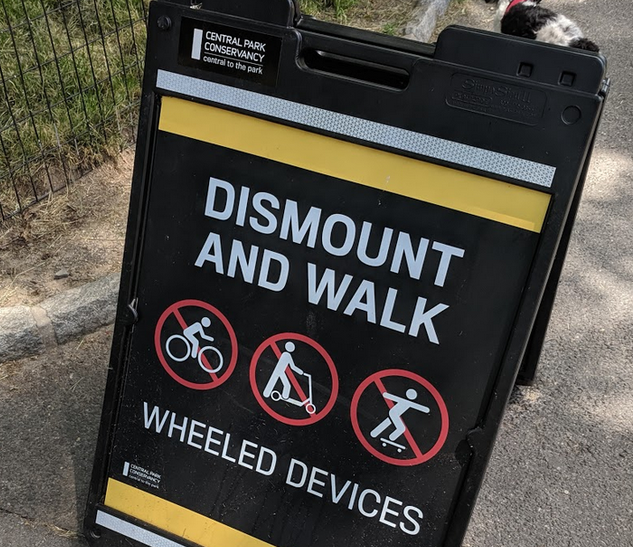City & State NY is hosting a full day New York in Transit summit on Jan. 30 at the Museum of Jewish Heritage. This summit will bring together experts to assess the current state of New York’s transportation systems, break down recent legislative actions, and look towards the future of all things coming and going in New York. Join Keynote Speaker Polly Trottenberg, commissioner of the NYC Department of Transportation, along with agency leaders, elected officials, and advocates. Use the code STREETSBLOG for a 25-percent discount when you RSVP here!
Upper West Siders are demanding that the city create safe routes for bike riders through Central Park, citing a lack of crosstown infrastructure that led to the death of a cyclist last month.
Despite many protected lanes in the neighborhood, there’s still a dearth of protected routes to get riders through Central Park — and no protected lanes on the Upper East East Side except for First and Second avenues far to the east.
“On the Upper West Side, cycling to destinations north or south has improved in the last decade — but vital east-west links that would make a true network of user-friendly, low-stress bike lanes are still missing,” Lisa Orman, director of Streetopia UWS, wrote to Mayor de Blasio on Jan. 6.
Members of the Manhattan Community Board 7 Parks and Transportation committees are expected to discuss the need for safe bike corridors on Jan. 14 — roughly a month after Dr. Daniel Cammerman was killed while biking on Central Park's 96th Street transverse on Dec. 18.
One of the board’s members says merely banning cars from the majority of Central Park in summer 2018 failed to solve the problem of keeping other road users safe — much of the park remains in “chaos” because cars and trucks have sole dominion over the four main crosstown transverses.
But the transverses are still the better option for many cyclists, who choose them instead of designated bike paths through the green space that are hilly, indirect or marked with signs demanding that bikers "dismount and walk."
“People are going to take the transverse because it’s the most direct route. Drivers have four crossings across Central Park to choose from. Cyclists have one route that is indirect and dangerous," said Ken Coughlin, a CB7 member.
29th cyclist killed this year was riding across 96th Street Central Park transverse where there is no bike lane. There is also no path to fully traverse east-west inside the park. Signs say dismount and walk.https://t.co/ZuhgrDTM4o https://t.co/3JVuiNZIJa
— Harry DiPrinzio (@hdiprinzio) December 18, 2019
But the signs discriminating against cyclists, telling them to walk instead of ride, were not put up by any city agency, but by the Central Park Conservancy, which has long been no friend to bikers, according to Coughlin.
Leaders of the organization, which helps oversee the green space, have put the kibosh on opportunities for more bike-friendly pathways, he said. Yes, the park has become a global tourist attraction, but that doesn't mean it always works for locals.
"Many advocates have met repeatedly with the Central Park Conservancy to try to find a way to allow cyclists to use some of the paths, and so far all we've been able to accomplish is one very short path in the middle of the park that is hilly and in very poor condition and does not connect the east and west side," said Coughlin.
A spokeswoman for the Central Park Conservancy said it merely follows the rules and regulations set by the Parks Department, which requires cyclists to dismount at certain locations for safety reasons. The Parks Department did not respond to a request for comment.
"The safety and well-being of all Central Park visitors is a top priority of the Central Park Conservancy. We work collaboratively with NYC Parks to support their rules and regulations. The dismount signs are placed to remind cyclists that riding on Park paths is prohibited under NYC Parks’ rules," said Stephanie Baez.
Coughlin said for too long the city has ignored his and other advocates calls to install protected bike lanes through the massive green space and finally give bikers the same options and amount of space for traveling through the park as drivers get before another cyclist gets killed.
"Dr. Cammerman was killed not just by a school bus, but by a city that has largely ignored pleas for safe passages for cyclists across Central Park," he said. “This is a clear case where infrastructure would have saved a life."
Safe streets save lives. The Central Park transverse roads and 5th Avenue are built for traffic, and are incompatible with #VisionZero. https://t.co/11Uz69MzR9
— Families For Safe Streets (@NYC_SafeStreets) December 20, 2019
Upper West Side Council Member Helen Rosenthal said she would advocate for one-way transverses in Central Park to minimize the amount of space designated for motor vehicles over bikers, and has been in touch with the Department of Transportation about it in the past, according to her office.
Since December 2018 — six months after cars were supposedly banned from Central Park — there have been 42 reported crashes, causing 17 injuries, including five to cyclists and two to pedestrians — along the four transverses that cut through the park, according to city data compiled by Crashmapper.
City Hall said it is reviewing Streetopia UWS's letter, and the Department of Transportation said it is aware of community suggestions to provide protected bike lane infrastructure on crosstown streets on the Upper West Side and looks forward to working with the local community board.
Manhattan CB7 meeting at 250 West 87th St. between West End Avenue and Broadway on Jan. 14 at 6:30 pm.
Update: This story has been updated with comments from the Department of Transportation and Central Park Conservancy.






